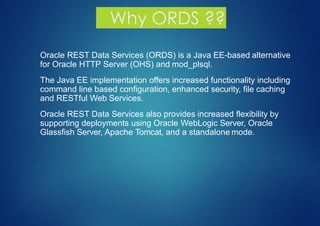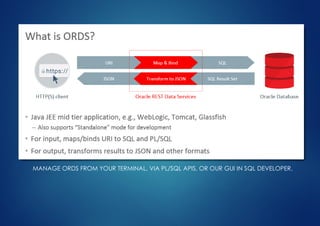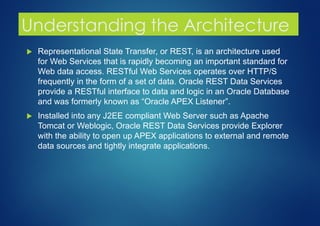Ad
Oracle restful api & data live charting by Oracle Apex - داشبورد آنلاین (داده ی غیر محلی)
- 1. Introduce ORDS and Data Live Charting Project by this service Mahdi Ahmadi
- 2. About Mahdi Ahmadi • We will keep this short: • My Name is Mahdi Ahmadi – born1995 in Iran. • Working since 2016 as a developer on APEX and PL/SQLprojects. • APEX Developer of the Year 2017. You can always reach me under the following email address: [email protected]
- 3. ■ Why using ORDS? ■ Things to consider ■ Understanding the Architecture ■ Rest Data Live Charting Agenda
- 4. Why using ORDS ?
- 5. Why ORDS ?? ▪ Oracle REST Data Services (ORDS) is a Java EE-based alternative for Oracle HTTP Server (OHS) and mod_plsql. ▪ The Java EE implementation offers increased functionality including command line based configuration, enhanced security, file caching and RESTful Web Services. ▪ Oracle REST Data Services also provides increased flexibility by supporting deployments using Oracle WebLogic Server, Oracle Glassfish Server, Apache Tomcat, and a standalone mode.
- 6. This is my Resource page for Oracle REST Data Services (ORDS), formerly known as the APEX Listener. ORDS doesn’t require APEX, and you can run APEX without ORDS. My posts here concentrate on core ORDS features, generally REST enabling your Oracle Database. ORDS is our middle tier JAVA application that allows you to access your Oracle Database resources via REST. In the tiniest and simplest of nutshells, GET|POST|PUT|DELETE|HEAD /db_stuff/ – ORDS maps a URI to something in your Oracle Database (a query, an object, an anonymous block, etc.), runs the appropriate SQL/PLSQL, and returns any output as JSON.
- 7. By using a stateless protocol and standard operations, REST resources are created to optimize for fast performance, reliability, portability, and growth. This is achieved by creating reusable underlying components that can be managed and updated without affecting the system, even while REST is running. RESTful services, is divided into two sections: Consuming RESTful services and Providing RESTful services. While consuming RESTful Services uses the standard HTTP operations, processing the data returned through a RESTful service is different. Oracle Application Express 18.1 provides a comprehensive set of components to make consuming RESTful services easier.
- 8. MANAGE ORDS FROM YOUR TERMINAL, VIA PL/SQL APIS, OR OUR GUI IN SQL DEVELOPER.
- 9. ▪ If using a setup with Oracle RDS, you can provide RESTFul Web Services using APEX Builder interface. ▪ If using Oracle RDS, you can use native Excel file upload in your APEX applications by extending the defaults.xml file: <properties> ... <entry key="apex.excel2collection">true</entry> <entry key="apex.excel2collection.onecollection">true</entry> <entry key="apex.excel2collection.name">EXCEL_COLLECTION</entry> <entry key="apex.excel2collection.useSheetName">true</entry> </properties>
- 10. Why this kind of setup at all? ▪ Infrastructure for Oracle APEX production environments often poorly configured: ▪ Still use the embedded PL/SQL gateway ▪ ORDS connection pool not properly configured ▪ People find it hard to implement the recommended setup with an Apache http server and ORDS, because it seems to be complicated ▪ My personal interest: ▪ Want to have a step-by-step guide to implement the recommended architecture ▪ Want to have a presentation to educate my clients regarding the architecture and the best setup
- 11. ▪ Download Oracle REST Data Services (ORDS) here: ▪ http://www.oracle.com/technetwork/developer-tools/rest-data- services/downloads/index.html ▪ Download Glassfish here: ▪ http://www.oracle.com/technetwork/java/javaee/downloads/ogs-3-1- 1-downloads-439803.html ▪ You will need Java installed on your server, in order to configure ORDS ▪ Download Tomcat (newest version) here: ▪ http://tomcat.apache.org/ Prerequisites
- 13. Understanding the Architecture Representational State Transfer, or REST, is an architecture used for Web Services that is rapidly becoming an important standard for Web data access. RESTful Web Services operates over HTTP/S frequently in the form of a set of data. Oracle REST Data Services provide a RESTful interface to data and logic in an Oracle Database and was formerly known as “Oracle APEX Listener”. Installed into any J2EE compliant Web Server such as Apache Tomcat or Weblogic, Oracle REST Data Services provide Explorer with the ability to open up APEX applications to external and remote data sources and tightly integrate applications.
- 15. http http JDBC Oracle Browser Webserver PL/SQL Gateway Oracle DB Serve static files SSL termination Cache / Proxy Translate URL /ords/f?p=100:1 => APEX: Execute Logic https AJP SQLNet Compression ... call to stored procedure & Generate HTML Apache Http Server, Nginx, IIS / Windows Apache Tomcat, Oracle XML DB ORDS mod_plsql dbms_epg ... Oracle 11.1.0.7 and higher Oracle XE 11g Understanding the Architecture
- 16. ▪ The WORK is done IN THE DATABASE ▪ The Webserver and PL/SQL gateway don’t need a lot of processing power, most of the time idle
- 17. ▪ The components in this presentation: ▪ Windows 8 64 bit (virtual machine) ▪ ORDS 3.0 ▪ Oracle XE 11g ▪ APEX 5.0.0
- 18. saTESnt Reurrncoo cgdinoracceSi sona iepoTSERor aol fopnoectnonCTSRE )4.2.2+XEPAhwiR (ESU_CLIBUP_STERX_EPA 002400_XEPy Aorosipeom rs fnon tDe iTESs RdaReads RES Definitions from repository APEX 040200e +)24.2.XEPAhwitR (ENETLISX_EPAPEX_LISTENER( WITH APEX 4.2.2+) OPTIONALLY installed when using REST services APEX_PUBLIC_USER APEX / OWA main connection pool Size according to number of concurrent apex users i t ORDS2.0 r t z i ll t c ll ■ Users APEX_LISTENER and APEX_REST_PUBLIC_USER were created using the script apex_rest_config.sql as part of the APEX installation.
- 19. R:ESU_CLIBPU_TSER_XEPA ndaRENTESLI_XEPAsersuehor td feenehst te iserhyntleurrC ORDS3.0 ■ ORDS 3.0 support RESTful Webservices even without APEX APEX_PUBLIC_USER APEX / OWA main connection pool Size according to number of concurrent apex users ORDS_METADATA Stores REST Definitions ORDS_PUBLIC_USER REST Connection pool for all REST operations Size according to concurent REST calls ■ t ill ■ The new download of static application files and static workspace files require it ■ So that you can continue to use the management interface in the SQL Workshop (else you have to use SQL Developer)
- 20. They get copied over from APEX_050000 => ORDS_METADATA Now they exist in two places redundantly In this situation the definition stored in ORDS_METADATA “wins” over the definition stored in APEX Through the management interface in APEX you still manage the “OLD” ■ Should we migrate the existing RESTful definitions in our APEX environment? ■ => !!! NO !!! ■ What happens? definition ■ This is too confusing, thus: ■ Keep the definitions separate ■ Either create new ones with SQL Dev directly or still using the SQL Workshop in APEX
- 21. Rest Data Live Charting
- 22. Purpose of this app The science of statistics is one of the branches of mathematical science that studies and analyzes statistical data. The statistical data is a collection of numbers that are derived from measurements and counting Different planning in social and economic affairs is not possible without the use of statistics and statistical analysis. Collection and adjustment of data is the first stage in statistical studies Charts are images that can quickly access existing information; you've heard that a good image worth a thousand words. By looking at a graph at a glance, you can see many features of a set of information. Today, the use of charts is very common. Graphs or curves show numerical and statistical information on a regular basis and map the relationship between two or more factors
- 23. Type Of Charts : You can put all sorts of charts in a few categories: linear, columnar, circular, and gauge. There are other types, but the basis of each of them is more and less in the form of one of three categories. For example, a graphic illustration of images of individuals and objects in relation to one of the three categories mentioned above.
- 24. JET Charts in Application Express 5.1 One of the most-mentioned new features in Application Express 5.1 are the new charts based on Oracle JET. JET is the abbreviation for Javascript Extension Toolkit. It is targeted at intermediate to advanced JavaScript developers working on client-side applications. It's a collection of open source JavaScript libraries along with a set of Oracle contributed JavaScript libraries that make it as simple and efficient as possible to build applications that consume and interact with Oracle products and services, especially Oracle Cloud services Oracle JET contains a lot of components for data visualization - and these are the foundation for the new chart types in Application Express 5.1. Note that not all JET visualizations are available as Application Express charts (at least at this time)
- 25. Describe Data Live Charting : Add Rest Services This application enables you to access RESTful services defined in your workspace as well as public services. The application provides metadata-driven mapping from service response data to SQL result set columns. Generated SQL and PL/SQL code can be and used in own applications. The examples in this application illustrate how to create a simple report on REST service data, how to filter, and how to add pagination. REST data can also be downloaded as csv file and staged into a local table for further processing, analysis, usage and creating customized any type of charts by Oracle Application Express components.
- 26. As shown in the below screenshots, you must do the following to get the data associated with the service: Naming the service and giving information related to its authentication Getting data in the selected response type Selecting the desired columns Selecting the service created and getting relevant data
- 28. By adjusting and setting values in the “Chart Settings” section to any of the chart types, you can have dashboard like below images.
- 29. Describe Data Live Charting : Page Settings Each chart type has its own customizable item in “Chart Setting” section For example : Orientation, Label, Value, Aggregation, Sort by, Direction,… and other items settings in Gauge chart type are Value Type, color or value ranges, … The values of the selected list for the items listed are completely dynamically generated, and each one varies depending on the Rest Services.
- 31. Describe Data Live Charting : Other Settings In the final section of this professional program we can point out: Ability to save settings of different type of charts Ability to save different settings of one type of charts Ability to select and activate one of the settings you are looking for Possibility to comment on the settings …
- 33. Questions?





































































































